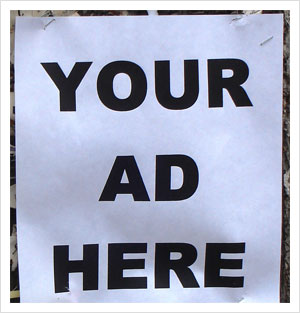This post originally appeared on Joe Wikert’s Publishing 2020 Blog (“Why Advertising Could Become Amazon’s Knockout Punch“). This version has been lightly edited.
 It all started harmlessly enough with Amazon’s Kindle with Special Offers. That’s the cheaper Kindle that displays ads when the device is in sleep mode or at the bottom of the screen when paging through the owner’s catalog of books. It is very unobtrusive and, since it lowered the price of the device, has made that Kindle an extremely popular device.
It all started harmlessly enough with Amazon’s Kindle with Special Offers. That’s the cheaper Kindle that displays ads when the device is in sleep mode or at the bottom of the screen when paging through the owner’s catalog of books. It is very unobtrusive and, since it lowered the price of the device, has made that Kindle an extremely popular device.
Now there are rumors that Amazon is selling ad space on the Kindle Fire’s welcome screen. That sounds pretty reasonable, too, as it’s a simple way for Amazon to drive a bit of additional income that’s pure profit for them.
Given that Amazon’s goal is to offer customers the lowest prices on everything, what’s the next logical step? How about even lower prices on ebooks where Amazon starts making money on in-book ads? Think Google AdWords, built right into the book. Of course, Amazon won’t want to use Google’s platform. They’ll use their own so they keep 100% of the revenue.
The changes the DOJ is requiring for the agency model means a retailer can’t sell ebooks at a loss, but they can still sell them for no profit, or break even. In other words, the 30% the retailer would keep on an agency ebook sale can be passed along to the customer as a 30% discount on the list price, but that’s as deep a discount as that retailer can offer.
The rules are different with the wholesale model. Amazon already loses money on sales of many wholesale-model ebooks. Let’s talk about a hypothetical wholesale model title with a digital list price of $25. Amazon is required to pay the publisher roughly half that price, or about $12.50 for every copy sold, but that ebook might be one of the many that are listed at $9.99 for the Kindle. So every time Amazon sells a copy, they lose $2.51 ($12.50 minus $9.99). Amazon has deep enough pockets to continue doing this, though, so they’re quite comfortable losing money and building market share.
So, what’s preventing Amazon from taking an even bigger loss and selling that ebook for $4.99 or $0.99 instead? In the wholesale model world, the answer to that question is: “nothing is preventing them from doing that.” And if selling ebooks at a loss for $9.99 makes sense, especially when it comes to building market share, why doesn’t it also make sense to sell them at $4.99, $0.99 or even free for some period of time? It probably depends on how much pain Amazon wants to inflict on other retailers and how much attention they’re willing to call to themselves for predatory pricing.
Make no mistake about the fact that Amazon would love to see ebook pricing approach zero. That’s right. Zero. That might seem outlandish, but isn’t that exactly what they’re doing with their Kindle Owner’s Lending Library program? Now you can read ebooks for free as part of your Prime membership. The cost of Prime didn’t go up, so they’ve essentially made the consumer price of those ebooks zero.
Why wouldn’t they take the same approach with in-book advertising?
At some point in the not-too-distant future, I believe we’ll see ebooks on Amazon at fire-sale prices. I’m not just talking about self-published titles or books nobody wants. I’ll bet this happens with some bestsellers and midlist titles. Amazon will make a big deal out of it and note how these cheaper prices are only available through Amazon’s in-book advertising program. Maybe they’ll still offer the ad-free editions at the higher prices, but you can bet they’ll make the ad-subsidized editions irresistible.
Remember that they can only do this for books in the wholesale model. But quite a few publishers use the wholesale model, so the list opportunities are enormous. And as Amazon builds momentum with this, they’ll also build a very strong advertising platform. One that could conceivably compete with Google AdWords outside of ebooks, too.
Publishers and authors won’t suffer as long as Amazon still has to pay the full wholesale discount price. Other ebook retailers will, though. Imagine B&N trying to compete if a large portion of Amazon’s ebook list drops from $9.99 to $4.99 or less. Even with Microsoft’s cash injection, B&N simply doesn’t have deep enough pockets to compete on losses like this, at least not for very long.
At the same time, Amazon will likely tell publishers the only way they can compete is by significantly lowering their ebook list prices. They’ll have the data to show how sales went up dramatically when consumer prices dropped to $4.99 or less. I wouldn’t be surprised if Amazon would give preferential treatment to publishers who agree to lower their list prices (e.g., more promotions, better visibility, etc.).
By the time all that happens, Amazon will probably have more than 90% of the ebook market and a nice chunk of their ebook list that no longer has to be sold at a loss. And oh, let’s not forget about the wonderful in-book advertising platform they’ll have built buy then. That’s an advertising revenue stream that Amazon would not have to share with publishers or authors. That might be the most important point of all.
What do you think? Why wouldn’t Amazon follow this strategy, especially since it helps eliminate competitors, leads to market dominance and fixes the loss-leader problem they currently have with many ebook sales?
Photo: Your Ad Here by KarenLizzie, on Flickr
Related:
